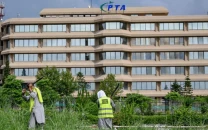Energy efficiency key to resolving power crisis
Pakistan can increase available power by up to 20% by plugging leaks.

While Pakistan’s per capita energy consumption compared to the global or Asian average is very low at about 450 kWh per year, this also means that there is great potential for growth. PHOTO: FILE
According to the Asian Development Bank (ADB), Asia is one of the fastest growing economic regions in the world, and it also has one of the biggest appetites when it comes to consuming power. Already Asia consumes about a third of the world’s energy resources and this is expected to rise as growth rates increase along with populations.
According to the ADB, most Asian economies already lag far behind in energy production, far short of domestic needs and rely mostly on imported power. This is perhaps doable for really fast-growing and cash-rich economies like Singapore or China, but is not a sustainable practice for a country like Pakistan which is constantly trying to boost its forex reserves and manage its balance of payments.
The only way forward for Pakistan is to increase power generation which it seems the current government is trying to do. It is trying to fast-track power projects like dams, Thar coal and nuclear as well as alternative energy projects in the areas of solar and wind power.

But another area that needs equal focus, if not more is energy efficiency. This incorporates not just efficiency in energy production but also conservation. It is predicted that like most other developing countries Pakistan will double its energy demand every decade. Pakistan already has one of the highest rates of energy utilisation per unit of dollar GDP and as global legislation becomes even tougher because of the greenhouse effect and climate change, this will severely stunt our ability to sustain growth.
While it is true that Pakistan’s per capita energy consumption compared to the global or Asian average is very low at about 450 kWh per capita per year, this also means that there is great potential for growth, and we should be ready for this.
The way forward
There a number of measures that can be taken to increase the overall efficiency of the energy chain. Some measures have already been taken like an audit of power producers so that the more energy efficient ones may be given priority in gas supply.
But this is just one link in the chain. The distribution of electricity is another huge drain on our electricity resources. Then there is the issue of unaccounted-for-gas (UFG) which is also very high and the gas utility companies constantly want this increased. The real solution is not to increase the allowance for UFG but to plug the leaks.

Awareness programmes to educate consumers about thesmart and efficient use of electricity, gas, water and other energy resources need to be launched and completed as soon as possible to plug the drain of valuable resources. The smart use of insulation to reduce the cooling or heating bill will also contribute to this.
It is therefore no surprise that by 2030 energy saved through improved efficiency is predicted to be so significant that it would become an important “fuel” in its own right. A developing nation like Pakistan would find it more cost effective to increase its energy supply through efficiency and conservation efforts as compared to building new generation capacity.
Conclusion
According to the Overseas Islamic Chamber of Commerce and Industry (OICCI) it’s a long drawn out process to reach optimum levels of energy efficiency because there are so many variables like political, financial and social issues that are linked to this process.
The OICCI, according a study, predicts that if all the stakeholders come together and work in cohesion there is no reason why Pakistan cannot reduce its energy consumption by about 20% in less than five years. That would help us shave off a significant chunk of Pakistan’s current level of energy imports, thus freeing up more fiancés to be invested in short-and long-term energy projects.
Published in The Express Tribune, July 29th, 2013.
Like Business on Facebook, follow @TribuneBiz on Twitter to stay informed and join in the conversation.



















COMMENTS
Comments are moderated and generally will be posted if they are on-topic and not abusive.
For more information, please see our Comments FAQ